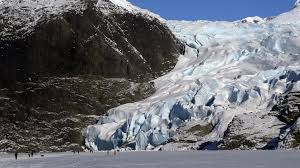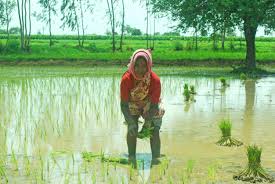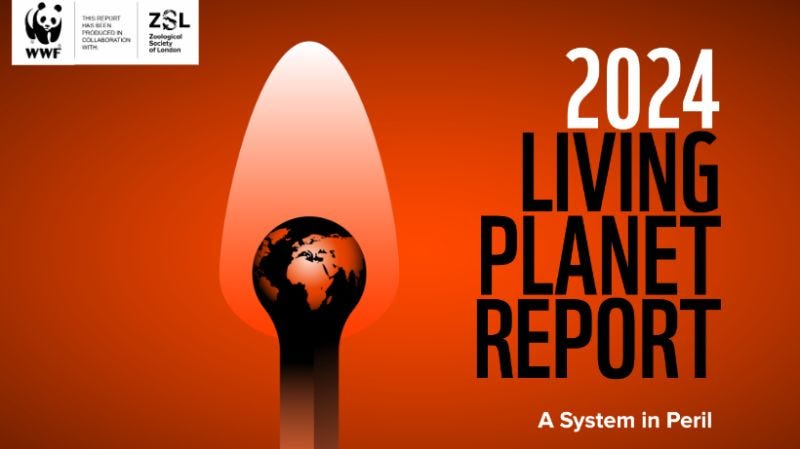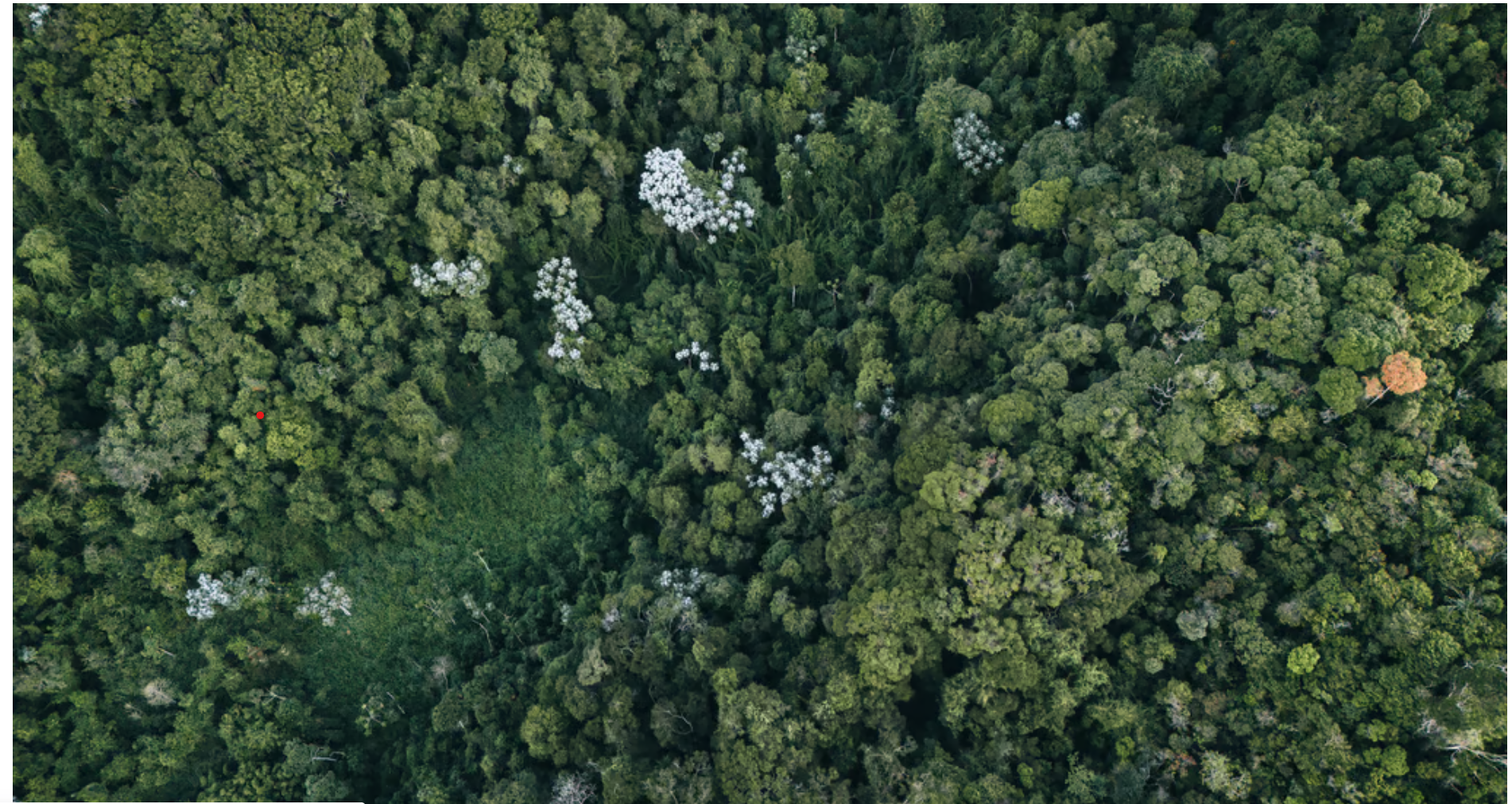Glacier Melting and Climate Change

- 25 Feb 2025
Context:
The world’s glaciers are melting at an alarming rate due to anthropogenic climate change, making them one of the leading contributors to global sea-level rise. Recent studies have revealed that more than 7 trillion tonnes of ice have been lost since 2000, with 2023 marking the worst year on record.
Key Data and Trends
- Between 2000 and 2023, glaciers lost 6.54–7 trillion tonnes of ice, contributing approximately 18 mm to global sea levels.
- The rate of glacier melt increased by 36% over the past decade:
- 2000–2011: 255 billion tonnes lost annually
- 2011–2023: 346 billion tonnes annually
- 2023 alone: 604 billion tonnes lost — the highest annual loss recorded
- Globally, glaciers have lost 5% of their ice, with regional losses ranging from 2% to 39%.
- Alaska is the fastest-melting region, losing 67 billion tonnes per year (22% of global glacier mass loss).
- The Canadian Arctic (20%), Greenland periphery (13%), and Southern Andes (10%) are also major contributors.
- Central European glaciers are shrinking the fastest in relative terms, having lost 39% of their volume since 2000.
Causes of Glacier Meltdown
- Rising global temperatures due to greenhouse gas emissions from fossil fuel combustion.
- Extreme heatwaves and record summer temperatures, especially in vulnerable regions like the Alps and Andes.
- Reduced snowfall, leading to insufficient accumulation to balance seasonal melting.
- Human-induced climate change, confirmed as the primary driver of accelerated glacier loss.
Impacts of Glacier Melting
- Sea Level Rise
- Glacier melt contributes more to sea-level rise than ice loss from Greenland and Antarctica.
- Currently accounts for 0.75 mm/year of sea-level rise; projected to increase further.
- Water Resources & Scarcity: Melting glaciers provide short-term water surpluses but pose a long-term threat of freshwater scarcity, especially for regions dependent on glacier-fed rivers (e.g., Central Asia, Central Andes).
- Geohazards & Natural Disasters: Glacier retreat increases the risk of glacial lake outburst floods (GLOFs), landslides, and downstream flooding.
- Biodiversity Loss: Shrinking glaciers affect freshwater ecosystems and species reliant on glacial water.
- Economic Disruptions: Sectors like agriculture and tourism are adversely impacted due to changes in water availability and scenic landscape loss.
Scientific Insights and Global Assessments
- The Glacier Mass Balance Intercomparison Exercise (GlaMBIE) led by international experts used unified satellite and field data to provide the most accurate glacier loss estimates to date.
- Glaciers are now recognized as apolitical indicators of climate change, painting an unbiased picture of global warming trends.
- The IPCC stresses that without rapid cuts in emissions, glacier melt will continue or accelerate throughout the century, worsening its contribution to sea-level rise and regional climate vulnerabilities.
- Glaciers contribute 20% to observed global sea-level rise (2003–2016), behind only thermal expansion (33%), and more than the Greenland Ice Sheet (17%).
Conclusion
Glaciers are not just scenic features; they are critical to Earth’s hydrological and climatic systems. Their rapid melting signals an urgent planetary emergency that demands intensified climate action, focused on mitigation, adaptation, and international cooperation. For India, where Himalayan glaciers are vital for river systems and agriculture, this global trend holds serious implications for water security, disaster risk management, and sustainable development.
Surge in E-Waste Generation in India
- 29 Dec 2024
In News:
India has seen a significant increase in electronic waste (e-waste) generation, rising by 72.54% from 1.01 million metric tonnes (MT) in 2019-20 to 1.751 million MT in 2023-24. The sharpest rise occurred between 2019-20 and 2020-21, driven by increased electronic consumption due to the COVID-19 pandemic's work-from-home and remote learning arrangements.
Environmental and Health Concerns
E-waste contains hazardous substances like arsenic, cadmium, lead, and mercury. If not properly managed, these materials can severely impact human health and the environment, contaminating soil and water sources.
Government Efforts: E-Waste Management Rules, 2022
- Introduction of Extended Producer Responsibility (EPR): The government introduced the E-Waste (Management) Rules, 2022, effective from April 1, 2023. These rules focus on making producers responsible for the recycling of e-waste. Producers are assigned recycling targets based on the quantity of e-waste generated or products sold and must purchase EPR certificates from authorized recyclers to meet these targets.
- Integration of Bulk Consumers: Public institutions and government offices, categorized as bulk consumers, are mandated to dispose of e-waste only through registered recyclers or refurbishers, ensuring proper treatment and recycling of the waste.
- Expansion of E-Waste Coverage: The updated rules expanded the scope to include 106 Electrical and Electronic Equipment (EEE) items from FY 2023-24, up from 21 items previously covered under the 2016 E-Waste Rules.
Challenges in E-Waste Recycling and Disposal
- Low Recycling Rates: Although the share of e-waste recycled in India has increased from 22% in 2019-20 to 43% in 2023-24, a significant 57% of e-waste remains unprocessed annually. Informal sector practices, which dominate e-waste handling, often lack the necessary environmental safeguards, leading to improper disposal and environmental contamination.
- Lack of Infrastructure and Awareness: India faces challenges in building adequate infrastructure for e-waste collection and recycling, resulting in improper disposal in landfills. Furthermore, a lack of public awareness regarding proper disposal methods exacerbates the problem.
Global Context and India’s Position
- India ranks as the third-largest e-waste generator globally, following China and the United States. With an increasing rate of e-waste generation, the country faces an urgent need to improve recycling efficiency and adopt sustainable disposal methods.
International and National Conventions on E-Waste
- India is a signatory to several international conventions that govern hazardous waste management, including the Basel Convention, which regulates the transboundary movement of hazardous wastes, and the Minamata Convention, which focuses on mercury. At the national level, India has established the E-Waste (Management) Rules, 2022, and other frameworks to manage and reduce e-waste effectively.
Strategic Recommendations for Effective E-Waste Management
- Harnessing the Informal Sector: India’s informal sector, which handles a significant portion of e-waste, must be integrated into the formal recycling systems. This can be achieved through training and financial support to ensure safe and environmentally responsible recycling practices.
- Technological Innovations: Encouraging research into advanced recycling technologies, such as AI and IoT-based solutions for efficient e-waste collection and tracking, will be crucial for improving the e-waste management system.
- Learning from Global Practices: Countries like the European Union (EU) and Japan have set strong examples. The EU’s Waste Electrical and Electronic Equipment (WEEE) Directive and Japan’s Home Appliance Recycling Law emphasize Extended Producer Responsibility (EPR) and provide models for India to adapt.
Conclusion
To address the growing e-waste challenge, India must improve its recycling infrastructure, integrate the informal sector, and adopt best practices from international models. With sustainable and effective strategies, India can mitigate the environmental and health risks posed by e-waste while promoting a circular economy.
Earning Instead of Burning
- 21 Nov 2024
In News:
Paddy straw burning, prevalent in Punjab, Haryana, and Uttar Pradesh, contributes to severe air pollution, especially during the post-harvest period in October and November. Despite various government measures and subsidies to reduce stubble burning, it continues due to economic and operational constraints faced by farmers. To address this issue, innovative technologies for the productive use of paddy straw need to be explored.
Stubble Burning: Causes and Consequences
Reasons for Stubble Burning
- Short Crop Cycles: The narrow window between paddy harvest and wheat sowing forces farmers to burn straw to prepare fields quickly.
- Economic Constraints: High costs of alternative residue management methods.
- Lack of Awareness: Farmers are often unaware of sustainable alternatives.
- Limited Mechanization: Availability of crop residue management machinery is inadequate.
- Policy Gaps: Ineffective enforcement of regulations and insufficient incentives.
Consequences of Stubble Burning
- Air Pollution: Emission of harmful pollutants like PM2.5, CO2, and CO contributes to air quality degradation.
- Health Hazards: Increased respiratory illnesses due to the inhalation of toxic fumes.
- Soil Degradation: Loss of essential nutrients and organic matter.
- Climate Change: Stubble burning releases greenhouse gases into the atmosphere.
- Economic Costs: Increased health care costs and loss of soil fertility.
Technologies for Paddy Straw Utilization
Large-Scale Technologies
- Direct Combustion:Burns rice straw under controlled conditions to generate heat for cooking and industrial uses. While its calorific value is lower than that of petrol and diesel, it is still viable for local energy generation.
- Pyrolysis and Gasification:
- Pyrolysis: Converts rice straw into bio-oil through heating at 200-760°C in the absence of oxygen.
- Gasification: Converts rice straw into syngas at higher temperatures (480-1,650°C) with limited oxygen. Challenges include low gas production and tar accumulation.
- Biochar Production:Rice straw is incinerated at lower temperatures to produce biochar, which is used as a soil conditioner to improve fertility, water retention, and reduce greenhouse gas emissions.
- Power Generation:Biomass-based power plants use rice straw to generate electricity, providing a sustainable energy source, especially for rural areas. States like Punjab, Haryana, and Uttar Pradesh are scaling up such plants.
- Pellet Production:Rice straw is compressed into compact pellets, improving its density, transportability, and combustion efficiency. These pellets can partially replace coal in power plants, offering an alternative use for crop residue.
- Biofuels:Conversion of rice straw into biofuels like ethanol and biogas helps reduce dependency on fossil fuels and supports the renewable energy transition.
- Paper Production:Rice straw, with its high cellulose content, is used as an eco-friendly alternative to wood in the paper and pulp industry, reducing environmental impact.
Small-Scale Technologies
- Composting:Rice straw can be composted to produce organic fertilizer, enhancing soil health. Vermicomposting is another effective method, though awareness among farmers remains low.
- Mushroom Cultivation:Rice straw serves as an ideal substrate for growing mushrooms, particularly species like Volvariellavolvacea. This practice provides an additional income source for farmers.
- Silica Extraction:Rice straw contains high silica content, which can be extracted for industrial applications like construction and electronics.
- Fodder for Ruminants:Though rice straw is low in digestibility due to high silica content, it can be used as animal feed after pre-treatment, such as drying, grinding, or chemical processes to enhance its nutritional value.
- Adsorbent for Pollution Control:Rice straw can be used to remove heavy metals and toxins from contaminated water, showing promise in environmental cleanup efforts.
- Soil Incorporation:Instead of burning, rice straw can be incorporated directly into the soil to improve fertility, moisture retention, and crop yield. This practice is already being adopted in regions like Punjab and Haryana.
Conclusion: Path Forward
Stubble burning continues to be a significant environmental challenge, but the development and adoption of technologies for utilizing paddy straw can offer viable solutions. Both large- and small-scale technologies can convert rice straw into valuable products like biofuels, power, and fertilizers. To ensure widespread implementation, efforts must be made to increase awareness among farmers and stakeholders, coupled with strong policy support and infrastructural investment. A collaborative approach involving the government, industries, and farmers is essential for sustainable management of rice straw, benefiting both the environment and the economy.
Andhra Pradesh's Natural Farming Model

- 18 Nov 2024
In News:
Andhra Pradesh's (AP) natural farming model presents a transformative opportunity to reshape the state’s agricultural landscape by 2050. An analysis by the Food and Agriculture Organization (FAO), in collaboration with the AP government, reveals how scaling natural farming could employ more farmers, increase incomes, and foster sustainable agricultural practices, potentially surpassing the benefits of conventional industrial agriculture.
AgroEco2050: Exploring Two Agricultural Futures
The AgroEco2050 initiative aimed to envision two possible futures for Andhra Pradesh’s agricultural systems by 2050:
- Industrial Agriculture Path: Focusing on intensification of conventional farming, relying heavily on chemicals, machinery, and monocultures.
- Natural Farming Path: Expanding agroecological practices, relying on regenerative, chemical-free farming methods to create more jobs, better livelihoods, and improve the environment.
The study compared these pathways, analyzing their impacts on employment, income, food production, biodiversity, and land use.
Key Findings: Natural Farming’s Impact on Employment and Income
- Employment Growth
- By 2050, natural farming would employ twice as many farmers as industrial agriculture: 10 million compared to 5 million.
- Unemployment in natural farming would decrease to 7%, in stark contrast to a projected 30% unemployment rate in the industrial agriculture scenario.
- Farmer Income
- Natural farming is expected to be more profitable for farmers due to lower input costs (seeds, fertilizers, machinery) and higher market prices for high-quality produce.
- The income gap between farmers and non-farmers, which stood at 62% in 2019, would decrease to 22% under natural farming by 2050, a sharp improvement compared to the 47% gap predicted under industrial agriculture.
What is Natural Farming?
Natural farming is an ecological, chemical-free farming system that emphasizes the use of locally available resources. Key practices include:
- Biodiversity-based pest management
- On-farm biomass recycling (e.g., mulching)
- Indigenous techniques like using cow dung and urine for soil fertility.
Globally recognized as a form of regenerative agriculture, it offers a sustainable alternative to industrial agriculture by sequestering carbon and restoring soil health.
Global Adoption
States like Andhra Pradesh, Karnataka, Himachal Pradesh, and others are already adopting natural farming. While still evolving, its acceptance among farmers is steadily growing.
Zero Budget Natural Farming (ZBNF) in Andhra Pradesh
Origin and Growth
- In 2016, Andhra Pradesh launched the Zero Budget Natural Farming (ZBNF) initiative to offer a sustainable alternative to capital-intensive agriculture.
- This program, implemented by RythuSadhikaraSamstha, targets covering 6 million farmers across 6 million hectares.
National Recognition
The ZBNF approach gained national attention when it was featured in the 2019 Union Budget, aimed at doubling farmers' incomes by 2022. The central government now promotes this model under the Paramparagat Krishi Vikas Yojana (PKVY).
Challenges in Scaling Natural Farming
- Farmer Training and Support
- Farmers need ongoing education and support to transition effectively to natural farming. Current training systems often fail to address the full scope of their needs.
- Certification Barriers
- The certification process for organic farming, including Participatory Guarantee Systems (PGS) and third-party certifications, is complex and costly, presenting a barrier for small-scale farmers.
- Marketing and Procurement Challenges
- There is a lack of effective marketing systems for organic products, which hampers the ability of farmers to sell their produce at fair prices.
- Without strong procurement or buy-back systems, farmers may struggle to find markets for their products.
- Policy and Funding Gaps
- Organic and natural farming programs still receive minimal funding compared to subsidies for chemical fertilizers, impeding large-scale adoption.
- Slow state-level implementation and a continued reliance on chemical inputs also delay the widespread shift to natural farming.
Moving Forward
- Scientific Research on Yields
- To address concerns about lower yields for staple crops, more scientific research is needed to assess the long-term viability of natural farming, especially for crops like wheat and rice, which are crucial for India’s food security.
- Localized Adoption
- Natural farming may be best suited for non-staple crops or localized farming, balancing sustainability with the need for food security.
- Risk Mitigation for Food Security
- Careful evaluation of natural farming’s impact on staple crop yields is necessary to avoid the food security risks witnessed in countries like Sri Lanka, where a sudden shift to organic farming led to reduced yields and increased prices.
Conclusion
The Andhra Pradesh natural farming model offers a promising alternative to industrial agriculture, with the potential to create jobs, improve farmers' incomes, and promote environmental sustainability. However, for this vision to become a reality, significant efforts must be made to address challenges related to training, certification, marketing, and funding. With continued research, policy support, and community involvement, natural farming can play a crucial role in feeding the future and promoting a more sustainable agricultural system.
WWF Living Planet Report 2024

- 02 Nov 2024
In News:
- The WWF Living Planet Report 2024 highlights a drastic 73% decline in the average size of monitored wildlife populations globally from 1970 to 2020.
- The report underscores the urgent need for biodiversity conservation to maintain ecological balance, food security, and human health.
Key Findings of the 2024 Report
Wildlife Population Decline
- 73% Decline in monitored wildlife populations over the past 50 years (1970-2020).
- Freshwater species: Declined by 85%, the most significant drop.
- Terrestrial species: Declined by 69%.
- Marine species: Declined by 56%.
Main Threats to Wildlife
- Habitat Loss: Primary driver, particularly due to the expansion of food systems.
- Overexploitation: Over-hunting, fishing, and resource extraction.
- Invasive Species: Non-native species disrupt local ecosystems.
- Pollution: Water, air, and soil contamination, especially in Asia-Pacific.
- Disease: Emerging diseases impacting wildlife populations.
Ecosystem Risks and Tipping Points
- Decline in wildlife signals risks of ecosystem tipping points.
- Critical ecosystems, like the Amazon and coral reefs, face potential irreversible damage.
- Impact on global food security and livelihoods due to ecosystem collapse.
India’s Wildlife Status
- Vulture populations in India remain critically endangered.
- Tiger populations have increased to 3,682 (2022).
- Snow leopards have been successfully monitored with 718 individuals recorded.
Case Study: Chennai’s Wetland Loss
- 85% reduction in Chennai’s wetlands due to urban expansion, exacerbating flood and drought risks.
- Initiatives like the Tamil Nadu Wetland Mission aim to restore these wetlands to improve ecosystem resilience.
Impacts of Wildlife Decline
- Ecosystem Imbalance
- Disruption in predator-prey relationships, pollination, and nutrient cycles due to species decline.
- Leads to ecosystem instability and potential collapse.
- Loss of Biodiversity
- Reduced genetic diversity makes ecosystems less resilient to environmental changes.
- Increases vulnerability to diseases, natural disasters, and climate change.
- Threats to Food Security
- Pollinators like bees and insects are essential for crop yields.
- Loss of pollinators threatens global food supply and agriculture.
- Human Health Implications
- Healthy ecosystems regulate disease by controlling pest populations.
- Declining biodiversity increases the risk of zoonotic diseases, such as COVID-19.
- Economic Consequences
- Agriculture, fisheries, and tourism industries depend on healthy ecosystems.
- Decline in wildlife can lead to job losses and economic instability.
- Cultural and Social Impacts
- Wildlife holds cultural, spiritual, and recreational value for societies worldwide.
- Loss of iconic species diminishes cultural identities and opportunities for nature-based tourism.
Challenges in Biodiversity Conservation
- Inadequate National Actions
- Despite global commitments (e.g., Global Biodiversity Framework, Paris Agreement, UN SDGs), national actions are insufficient to meet 2030 biodiversity targets.
- Risk of crossing tipping points that could lead to irreversible ecosystem degradation.
- Key Drivers of Biodiversity Loss
- Habitat Loss: Driven by agriculture, urbanization, and infrastructure development.
- Climate Change: Rising temperatures, extreme weather, and altered precipitation patterns.
- Overexploitation: Unsustainable hunting, fishing, logging, and resource extraction.
- Pollution: Industrial, agricultural, and plastic pollution disrupt natural habitats.
- Invasive Species: Non-native species outcompeting and threatening native populations.
- Lack of Funding: Inadequate financial resources for effective conservation.
- Weak Policy and Enforcement: Poorly implemented habitat protection laws.
- Human-Wildlife Conflict: Increased interactions between expanding human populations and wildlife.
- Genetic Diversity Loss: Reduced genetic diversity makes species vulnerable to diseases and environmental changes.
- Awareness Gaps: Insufficient public awareness on the importance of biodiversity.
Conclusion and Way Forward
Policy and Action Recommendations
- Expand protected areas and restore ecosystems to halt biodiversity loss.
- Engage Indigenous communities in conservation and land management practices.
- Promote sustainable farming, reduce food waste, and encourage plant-based diets to lessen food production impacts.
- Shift to renewable energy and reduce fossil fuel use to mitigate climate change.
- Redirect investments from environmentally harmful sectors to nature-friendly industries.
WWF-India’s Call for Collective Action
- WWF-India advocates for collective action to align climate, conservation, and sustainable development policies.
- The goal is to ensure a resilient and thriving future for both biodiversity and human societies.
Climate Change and Methane Emissions in the Amazon Rainforest

- 16 Oct 2024
Overview
Recent research from the University of São Paulo reveals that climate change is poised to significantly disrupt the methane cycle in the Amazon rainforest, with potential global repercussions. Rising temperatures and increased flooding are impacting microbial activity in both floodplain and upland forest soils, leading to contrasting changes in methane dynamics.
Key Findings
- Methane Uptake Reduction: The study indicates that methane absorption in upland forest soils could decrease by as much as 70% in warmer, drier conditions. This reduction diminishes the forest's role as a methane sink.
- Floodplain Contributions: Floodplains, which cover over 800,000 square kilometers during the rainy season, contribute up to 29% of global wetland methane emissions. Here, methane-producing microbes thrive due to the breakdown of organic matter.
Understanding the Methane Cycle
- Definition: The methane cycle encompasses the processes that control the production, consumption, and release of methane (CH4) in the environment.
- Microbial Roles:
- Methanogens produce methane, primarily in waterlogged conditions.
- Methanotrophs consume methane, living in drier, oxygen-rich soils. These interactions are critical in regulating methane levels in the atmosphere.
- Sources and Sinks: While wetlands and other environments release methane, hydroxyl radicals (OH) in the troposphere act as a natural sink, helping to oxidize methane into carbon dioxide.
Climate Change Impacts on the Methane Cycle
- Imbalance of Sources and Sinks: As global temperatures rise, the release of methane from soils may increase, exacerbating climate change effects.
- Melting Clathrates: Methane clathrates, trapped in cold sediments, are at risk as warming causes them to release methane, further contributing to greenhouse gas concentrations.
Global Consequences of Methane Disruption
- Climate Change Amplifier: Methane is the second most significant greenhouse gas, with a global warming potential 28 times greater than carbon dioxide over a century.
- Air Quality and Health: Increased methane emissions can lead to higher levels of tropospheric ozone, resulting in respiratory health issues and reduced air quality.
- Biodiversity Threats: The changes in methane dynamics can destabilize ecosystems, leading to shifts in species distributions and loss of biodiversity.
Balancing the Methane Cycle
To mitigate the impacts of methane emissions, various strategies can be employed:
- Enhanced Landfill Design: Utilizing gas collection systems to capture methane for energy rather than allowing it to escape.
- Livestock Management: Introducing feed additives to reduce methane emissions from ruminants.
- Sustainable Agricultural Practices: Implementing techniques like alternative wetting and drying in rice cultivation to lower methane output.
- Soil Health Improvements: Promoting organic fertilization and crop rotation to foster aerobic conditions in soils.
Research Insights
The study involved subjecting soil samples from floodplains and upland forests to elevated temperatures and varying humidity levels. Results indicated:
- Stable methane emissions in floodplains alongside an increase in methane-producing microbes.
- A significant decline in methane uptake in upland soils due to temperature sensitivity, with higher temperatures reducing microbial diversity.
Conclusion
The Amazon rainforest plays a crucial role in regulating global methane levels, and its response to climate change is vital for understanding future greenhouse gas emissions. As these ecosystems face increased pressure from rising temperatures and changing hydrological conditions, it becomes imperative to enhance our understanding and management of methane dynamics to mitigate broader climate impacts.
